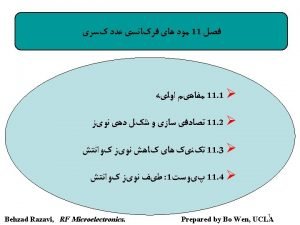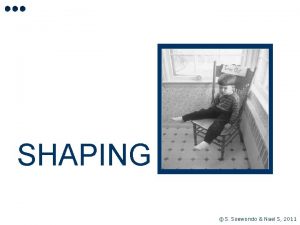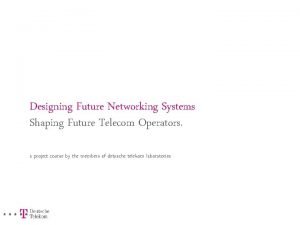SHAPING THE FUTURE OF ENERGY Energy Agenda for














- Slides: 14

SHAPING THE FUTURE OF ENERGY Energy Agenda for the Future – May 22, 2014 1

OUTLINE 1. Why we need to rethink our energy system 2. What we’re driving towards 3. How we get there 2

Why What BURDEN ON RATEPAYERS Electric Bill for Average Middletown Household* (600 k. Wh) : 2004 -2013 $70, 00 $60, 00 $50, 00 $40, 00 $30, 00 $20, 00 $10, 00 $0, 00 2004 2005 2006 2007 Delivery 2008 2009 2010 Commodity *Representative Upstate City 2011 2012 2013 Surcharge 3 How

Why What BURDEN ON RATEPAYERS Over the last ten years, $17 billion was invested in New York State’s electricity infrastructure. Over the next ten years, an additional $30 billion in capital investments is needed just to maintain our infrastructure. 4 How

Why What BURDEN ON RATEPAYERS rate of capacity utilization: under 60% 5 How

Why What BURDEN ON RATEPAYERS Capacity Utilization Rates Across Sectors 90 80 79% 70 71% 60 50 40 57% 30 20 10 0 NYS Electrical System Auto Plants* All Manufacturing* *2013 Capacity Utilization Data from U. S. Federal Reserve 6 How

Why What BURDEN ON RATEPAYERS 35% of energy used in residential and commercial sectors is wasted 7 How

Why What BURDEN ON RATEPAYERS Our current path is not sustainable. 8 How

Why What SHIFTING COMPETITIVE LANDSCAPES Ø Oklahoma is generating wind power at $. 03/k. Wh Ø Austin Energy signs solar PPA at $. 05/k. Wh Ø Battery costs declining 20 -30%/year: less than $200/k. Wh by 2020? ($1000/k. Whr in 2009 -2010) 9 How

Why What INNOVATION SITTING ON THE SIDELINES These are the types of homegrown companies we need to continue to innovate and create jobs here in New York State. 10 How

Why What A SENSE OF URGENCY IS NEEDED Extreme weather threatens our well-being and way of life. . . 11 How

Why What How REFORMING OUR APPROACH The State Energy Plan seeks to. . . Ø Give customers more choice, control, and value in their energy usage for each dollar spent Ø Incentivize utilities to focus on system and capital efficiency Ø Align energy policies and the use of ratepayer funds to animate private markets and scale deployment Ø Provide a bridge to a self-sustaining, private sectordriven clean energy markets 12

Why What PUTTING POLICY TO WORK Over the past year. . . Ø LIPA : PSEG Long Island Utility 2. 0 Ø NY Green Bank To accelerate clean energy deployment in NYS by working in partnership with the private sector to establish dynamic, self-sustaining financing markets Ø Clean Energy Fund To enhance the State’s energy efficiency and renewable programs and improve leverage, while also managing their transition to market-based clean energy activities Ø NY-Sun $1 billion commitment to significantly expand deployment of clean energy and transform New York’s solar industry to a subsidy-free sector §NYPrize : Community Microgrid Competition 13 How

Why What REFORMING THE ENERGY VISION REV includes the goals and vision of this administration. . . A public regulatory proceeding to q improve system efficiency q create price signals that will help markets work better q develop competitive markets around customers to provide more choice and value “In one of the most promising moves in the energy sector in years, New York State is proposing a way to get a head start on, and perhaps help lead, a revolution in the world of electricity generation. ” New York Times, “Smarter Electricity in New York” May 13, 2014 “New York Prodding Utilities to Shift From Monopoly Model… The move would spur generation from thousands of smaller systems owned by individuals and other companies -- notably rooftop solar panels. ” Bloomberg, May 12, 2104 14 How
 Future continuous i future perfect
Future continuous i future perfect Future continuous and future perfect
Future continuous and future perfect Shaping rotary's future
Shaping rotary's future Agenda sistemica y agenda institucional
Agenda sistemica y agenda institucional Present perfect future tense
Present perfect future tense Have en futuro simple
Have en futuro simple Future continuous and future perfect
Future continuous and future perfect Future nurse future midwife e learning
Future nurse future midwife e learning Present progressive repetition with always
Present progressive repetition with always Present continuous for future plan
Present continuous for future plan Verbal times
Verbal times Future plans and finished future actions
Future plans and finished future actions Future continuous and future perfect
Future continuous and future perfect Kondicional 1 engleski
Kondicional 1 engleski Fspos vägledning för kontinuitetshantering
Fspos vägledning för kontinuitetshantering


























